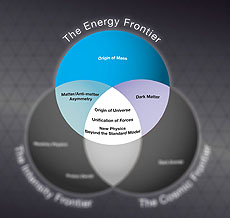Why high energy?
 |
The energy frontier allows physicists to pursue the highest-energy phenomena accessible by modern techniques. |
Fermilab is a high-energy physics laboratory. Did you ever wonder just exactly why high energy is something that physicists like? What is it about high energy that makes it attractive?
There are at least three reasons why energy matters. The first involves Einstein's famous equation E = mc2. Simply put, it says that energy and mass are equal, up to the c2 term, which is really nothing more than a conversion factor used much like how you would convert inches to feet. Thus having high energy means you can make high-mass particles. The high energy that was available at the Tevatron and the even higher energy available at the LHC means that researchers have the ability to make high-mass particles.
A second reason to use high-energy beams stems from the world of quantum mechanics. All light and matter have a wavelength. Wavelength and energy have an inverse relationship: the higher the energy, the shorter the wavelength. A shorter wavelength is nice because it acts as a more precise probe, allowing us to see smaller things. In order to see whether quarks, which are already pretty small, have something inside them will require even shorter wavelengths. Given that there is circumstantial evidence that quarks are not the final story in mankind's long quest to find the smallest building blocks of matter, there is a strong motivation to make higher-energy beams as a way to find the next layer in the quantum onion.
The third reason to make very high-energy beams is that high-energy collisions result in the hottest possible temperatures. An LHC collision can generate temperatures that are 100,000 times hotter than the center of the Sun, heating matter to temperatures last common in the universe 14 billion years ago, a scant trillionth of a second after the Big Bang. Higher-energy collisions allow us to peer further and further back in time, approaching the moment of creation itself.
If we learn more about heavier and smaller particles, we will learn more about how the universe came into existence and will better understand the building blocks of the matter that make up everything we've ever seen. These ageless questions have bothered mankind for millennia. More energy brings us closer to the answer.
—Don Lincoln
Click here to read the expanded column on the Energy Frontier.
|